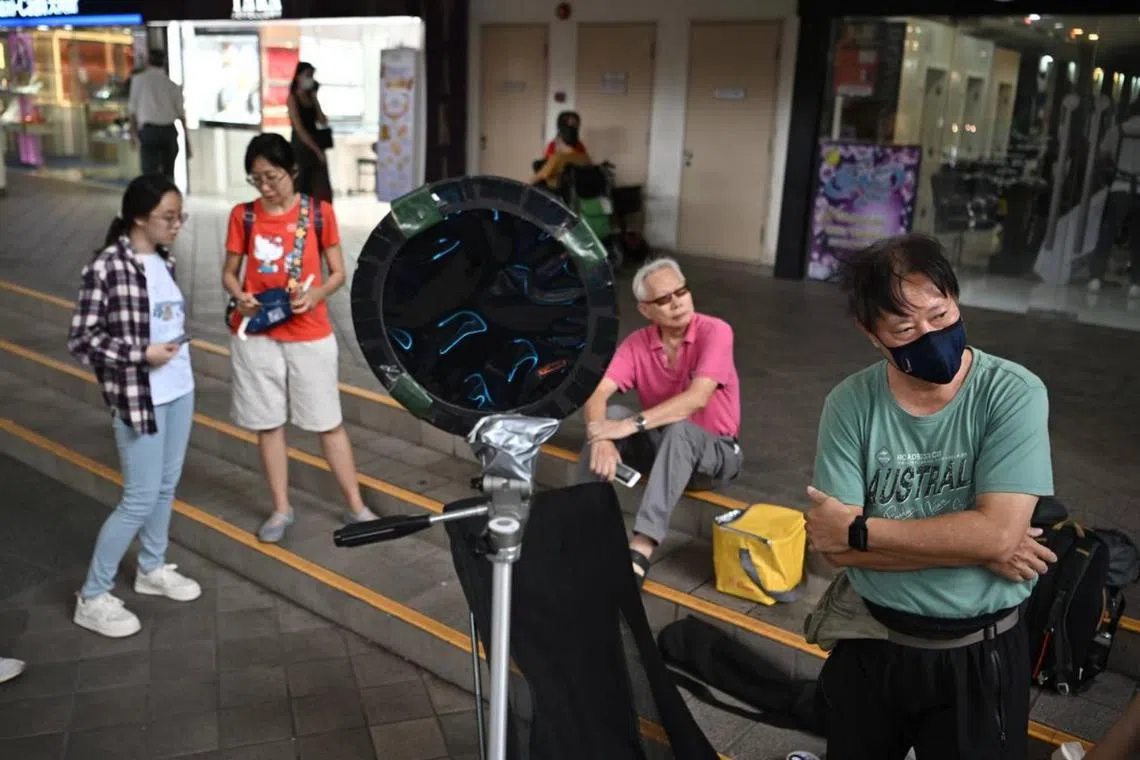Rare hybrid solar eclipse obscured by rain clouds in Singapore
Sign up now: Get ST's newsletters delivered to your inbox
Follow topic:
SINGAPORE – Around 800 people gathered at Science Centre Singapore to view a partial solar eclipse on Thursday morning, but the sun was obscured by clouds on the rainy day.
The rare astronomical event was supposed to be visible in Singapore between 10.54am and 12.58pm, with the peak of the eclipse at 11.55am.
By noon, the crowds – some armed with cameras with special filters, and others with glasses made for viewing eclipses – were still not able to catch a glimpse of the eclipse as the rain continued.
Others across the island, such as hobbyists from the Singapore Sidewalk Astronomy club who gathered at Toa Payoh Hub for the eclipse, were also left disappointed by the overcast weather.
However, some 200 people got to watch a total solar eclipse streamed live from Exmouth in Western Australia
According to the Science Centre Observatory, a total solar eclipse could be observed in some places around the world, including in Australia. This is where the Moon completely covers the Sun, as the Moon’s apparent size is at its largest.
A partial eclipse, where only a part of the Sun is covered, was visible in Singapore, Indonesia, the Philippines and Papua New Guinea.

Science Centre Singapore hosted a viewing session at its Ecogarden with telescopes set up to offer a safe and magnified view of the eclipse.
ST PHOTO: GAVIN FOO
In Singapore, the Moon was expected to cover about 15 per cent of the Sun at the peak of the eclipse. This partial eclipse near noon would have been visible from most places across the island as the Sun would be directly overhead.
Mr Tan Jyh Harng, senior science educator at the Science Centre, explained the significance of the event: “It is a hybrid solar eclipse, which is relatively rare as it requires strict conditions to happen and occurs only around once every decade.”
A hybrid solar eclipse is special, he said, as both a total eclipse and an annular eclipse are happening at the same time along the “path of totality”. What an observer sees depends on where he is located.
The path of totality refers to where the darkest part of the Moon’s shadow moves across the Earth’s surface and an annular eclipse occurs when the Moon does not completely cover the Sun, leaving a “ring of fire” that is visible.
“In a regular solar eclipse, it is either a total eclipse or an annular eclipse, no matter where you view it along the path of totality. That is why there is a lot of enthusiasm to catch a hybrid solar eclipse.”
Science Centre Singapore hosted a viewing session on Thursday at its Ecogarden with telescopes set up to offer a safe and magnified view of the eclipse. It attracted astronomy fans and schoolchildren. By 12pm, many who were there to watch the eclipse had given up and left the Science Centre.
“It feels like a wasted trip,” said Madam Helen Lau, 75, who was there with her daughter to see an eclipse for the first time.
“Watching the live stream doesn’t beat the real experience – I was so excited about the eclipse, I rushed to buy solar glasses online, but now I just feel disappointed.”
On average, there are two to five solar and lunar eclipses each year. A total eclipse takes place every 18 months or so. The visibility of the eclipse depends on each viewer’s location.
The next solar eclipse forecast to be visible in Singapore is on Aug 2, 2027 – a partial eclipse occurring during sunset, which is difficult to see. Following that, another partial solar eclipse is expected to be visible in Singapore on July 22, 2028.

Mr James Ling (extreme right), together with Singapore Sidewalk Astronomy members, waiting for the solar eclipse to appear at Toa Payoh Hub at 11.22am on April 20.
ST PHOTO: LIM YAOHUI
Here are some tips from the Science Centre Observatory on viewing eclipses:
– Looking at the eclipse directly with the naked eye is unsafe. The use of sunglasses and common household or vehicular solar films is also insufficient and eye damage can result.
– To ensure the eyes are protected, viewers must use special solar filters. Those using telescopes or binoculars should have proper solar filters for the equipment.
– Solar glasses and viewers built for solar observation can be purchased from the Curiosity Shop and the Astro Scientific Centre store at the Science Centre. These are priced at $5 and $5.90.

To ensure adequate protection for the eyes, viewers must use special solar filters when viewing eclipses.
ST PHOTO: GAVIN FOO

